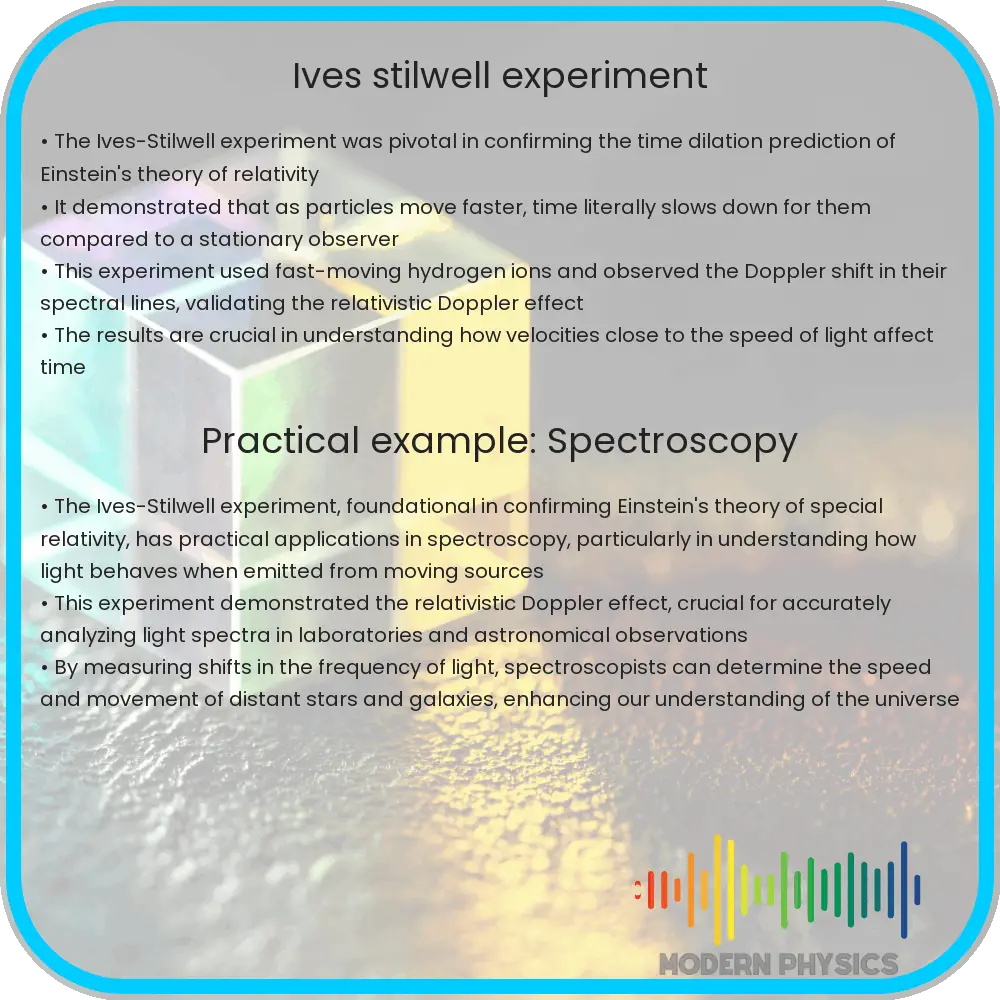Explore the Ives-Stilwell Experiment’s role in confirming time dilation and its impact on Einstein’s Theory of Relativity and modern physics.

Understanding the Ives-Stilwell Experiment: A Cornerstone in Modern Physics
The Ives-Stilwell experiment, conducted in the 1930s by Herbert E. Ives and G.R. Stilwell, stands as a pivotal validation of the Special Theory of Relativity proposed by Albert Einstein. This groundbreaking experiment was designed to test the phenomenon of time dilation, a fundamental aspect of relativity, which suggests that time can ‘slow down’ for objects moving at high velocities. The implications of this experiment extend far beyond its historical context, continuing to influence contemporary physics and our understanding of the universe.
Time Dilation: A Relativistic Effect
At the core of the Ives-Stilwell experiment is the concept of time dilation. According to Einstein’s Special Theory of Relativity, time is not an absolute entity but varies with the velocity of the observer. In essence, as an object approaches the speed of light, time for that object slows down relative to a stationary observer. This was a radical departure from the Newtonian view of absolute time and space.
The Experiment’s Design and Execution
The Ives-Stilwell experiment ingeniously utilized the Doppler effect, a phenomenon observed when the frequency of light or sound waves changes due to the relative motion of the source and the observer. They focused on measuring the frequency of light emitted by a moving source. By comparing the observed frequency with the known emitted frequency, they could test the predictions of time dilation. This involved observing the spectral lines of hydrogen atoms moving at high speeds in a vacuum tube, allowing them to precisely measure any shifts in frequency.
Significance in the Validation of Special Relativity
The results of the Ives-Stilwell experiment provided one of the first direct confirmations of time dilation, a cornerstone of Einstein’s theory. The experiment showed that the frequency of light from the moving hydrogen atoms was indeed red-shifted (shifted towards the red end of the spectrum) when moving away from the observer and blue-shifted (shifted towards the blue end) when moving towards the observer. These shifts were consistent with the relativistic predictions, differing from the classical Doppler effect that would be expected in a Newtonian framework.
By validating the concept of time dilation, the Ives-Stilwell experiment played a crucial role in bolstering the Special Theory of Relativity. It not only reinforced Einstein’s revolutionary ideas but also paved the way for further exploration in the realms of physics, cosmology, and the very understanding of space and time.
Implications and Legacy of the Ives-Stilwell Experiment
The success of the Ives-Stilwell experiment had profound implications for physics and our comprehension of the universe. It not only confirmed the predictions of the Special Theory of Relativity but also opened new avenues in scientific thinking. The realization that time could vary with velocity challenged the traditional Newtonian mechanics, which had been the foundation of physics for centuries. This experiment contributed significantly to the shift towards a relativistic view of the world, where time and space are interconnected and relative to the observer’s motion.
Advancements in Modern Physics and Technology
The principles validated by the Ives-Stilwell experiment have been instrumental in the development of modern physics and technology. For example, the Global Positioning System (GPS) relies on an understanding of time dilation to provide accurate positioning data. Satellites in orbit experience time slightly differently than clocks on Earth due to their high velocities and the effects of gravitational time dilation, another aspect of Einstein’s theory. The incorporation of relativistic corrections ensures the system’s accuracy.
Continued Relevance in Scientific Research
The experiment’s methodology and findings continue to influence contemporary scientific research. In particle physics, accelerators routinely propel particles to speeds close to the speed of light, necessitating the use of relativistic principles to predict and analyze particle behavior. Astrophysics and cosmology also leverage these concepts to understand phenomena such as the behavior of light in strong gravitational fields and the expansion of the universe.
Conclusion
In conclusion, the Ives-Stilwell experiment stands as a testament to the power of human curiosity and the pursuit of scientific truth. By confirming the relativistic effect of time dilation, it not only validated Einstein’s Special Theory of Relativity but also revolutionized our understanding of the fundamental nature of time and space. The experiment’s legacy continues to resonate in various fields of science and technology, illustrating the enduring impact of this landmark study in the annals of physics. As we continue to explore the mysteries of the universe, the principles unearthed by Ives and Stilwell remain pivotal in guiding our understanding of the cosmos and the laws that govern it.
Is this conversation helpful so far?
